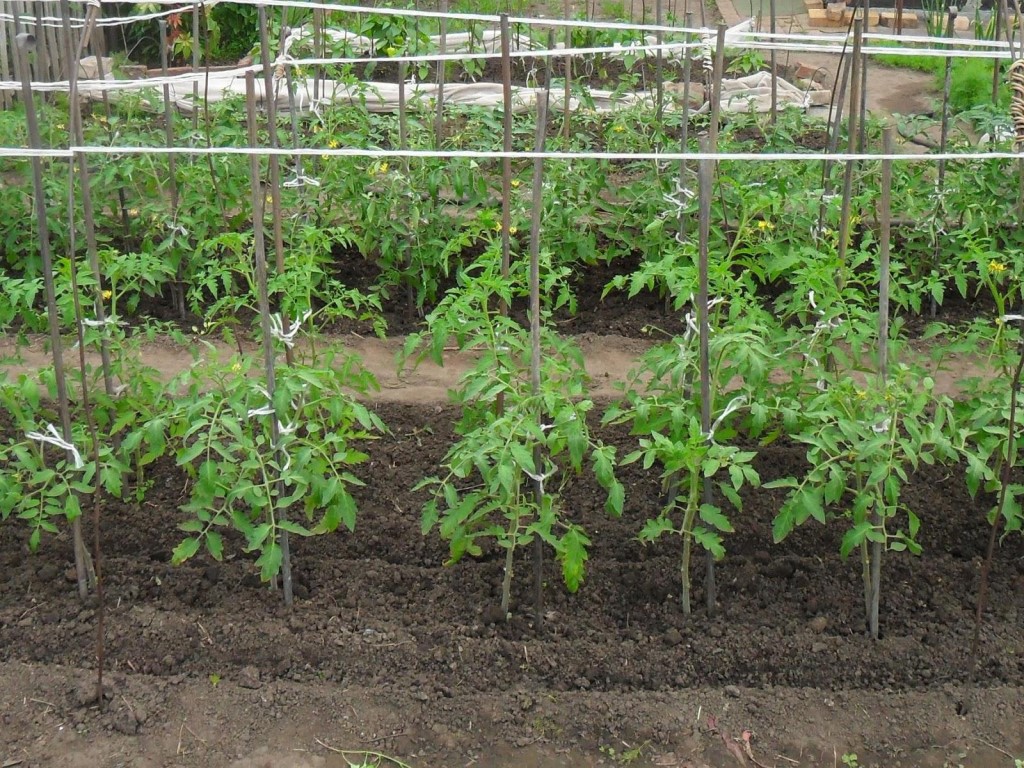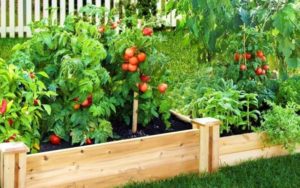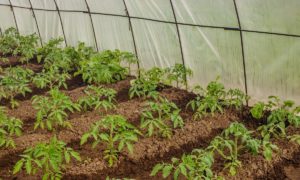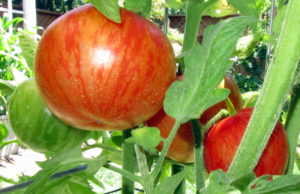Lazy garden bed for tomatoes

Growing your own tomatoes allows summer residents not only to diversify their menu with environmentally friendly vegetables grown by themselves, but also to stock up with pickles for the winter. I would like to work in the garden brought as little as possible trouble, and the harvest was rich.
Compliance with a number of tricks will help to save their own time and energy, and at the end of the season to get ripe and juicy tomatoes.
One of the ways to get a good harvest of tomatoes with the lowest labor costs is a special method of cultivation. Experienced gardeners practice growing tomatoes in a lazy way by organizing high beds.
Why tomatoes high bed

A high bed is a soil raised above the main level of the garden, which is framed by the edges. Growing tomatoes in a box minimizes the effort to care for tomatoes.
Raised above the general level of the ridge does not require a large area. The compact earthen box can be placed in any corner of the plot that is well lit by the sun. Effective cultivation of tomatoes is possible not only in the finished greenhouses, but also in the open field. High ridges have proven to be the most productive. The advantages of high ridge boxes are:
- the soil does not erode when watering, during seasonal melting of snow and during rains;
- always clean between the mountains;
- the correct geometry of the location of the ridges, aesthetic appeal;
- the possibility of covering tomatoes during an invasion of pests or with the danger of nighttime cold weather;
- obstacle to the growth of weeds from the row spacing.
Tomatoes are tall crops. It is necessary to give them the maximum amount of useful nutrients for growth and fruiting. Raised soil and the growth of culture in it allows to reduce the time for watering and create optimal conditions for tomatoes.
Variants of tomato beds
You can organize on your site various types of beds for tomatoes.
| Ordinary | High | Narrow | |
| Paths between ridges | Overgrown with weeds, which can occupy a useful area | Weeds from the paths can not penetrate into the soil through the side | Aisle can be made large |
| Dimensions | Any. Keep in mind that wide ridges make it difficult to care for tomatoes. | Ridge sizes are up to 1.2 m wide. Lengths can be any | Width is up to 50 cm that provides optimum care of plants |
| Tomato arrangement | Any layout | Most often landing in 2 rows. The distance between the rows of 30-60 cm | Planting tomatoes in 1 row |
| Possibility of shelter | There is no way to cover tomatoes in case of sharp frosts. | When setting arcs it is possible to cover the tomatoes. It is easy to take care of the tomatoes, rolling the edge on one side alternately | The possibility of sheltering tomatoes hip method. Install the support in the middle of each edge of the narrow ridge and set the crossbar on them. Over throw a canvas |
| Border trimming | Not necessary | Using boards or other material up to 40 cm high | Using boards or other material up to 20 cm high |
The advantages of high beds are:
- easy access to tomatoes;
- convenience for weeding;
- unrestricted access for fertilizer application;
- possibility of full loosening;
- abundant watering;
- the possibility of spraying;
- the possibility of using covering material.
Narrow and high beds with full-fledged watering and timely application of top-dressings always give greater yield than tomatoes grown on ordinary ridges.
What height should be bed

A high bed for tomatoes should be raised above the main level of the garden to a height of at least 20 cm. The optimum height for raising the soil for growing tomatoes is 40 cm. With such a height, the root system has enough space for full development. Tomato optimally rooted when transplanting seedlings, has enough space for growth, receives the necessary amount of nutrients and moisture.
Tall and narrow beds are named after their founder. They are called Mittlider beds. This is the name of a famous American agronomist-grower.
In high varieties of the ridges, planting of tomatoes in one or two rows is most often used. This is the optimal pattern of planting culture and provides the most convenient approach to plants for care.
Location
High beds can be placed anywhere in the area. For tomatoes, it is preferable to pick a well-lit area, closed from drafts. It is not recommended to organize any ridges for growing tomatoes near bushes, trees, buildings, in shaded places.
You can arrange high beds 0.5 or 1.2 m wide of any length with any arrangement. It is convenient to have only one variety of tomatoes in one row-box. This will help to observe exactly which tomatoes give a good harvest in your area.
Mezhgarryadiya

Between high beds, you should ensure a distance of at least 50 cm. This distance is most convenient for a comfortable passage, including if you have a tool or container for watering or fertilizer in both hands.
To the areas between the beds are not overgrown with weeds, they can be sown with lawn grass. It does not threaten relocation to the tomato ridge and does not require special care. You will not slip if the main type of soil in your area is dominated by clay.
Do I need drainage
Elevation of the soil above the general level of the vegetable garden ensures optimal drainage of excess moisture into the deep soil layers. Specially organize the drainage for high beds is not necessary. On a high bed with timely watering and loosening, favorable conditions for the growth of tomatoes are ensured by aeration and humidity.
You can not worry about frequent watering of tomatoes. In the high beds moisture is delayed for a long time. With heavy and prolonged rains, the water itself goes into the aquifer, not remaining in the raised ground.
High bed care
It is advisable at the very beginning of an orderly approach to the creation of high beds. Development stages are:
- deep digging of the soil with a rise of up to 40 cm above the general level of the vegetable garden;
- construction of sides (material can be boards, timber, slate, sheet metal, stone, brick, etc.);
- filling up the soil if necessary;
- introduction of mineral and organic fertilizers;
- setting removable arcs. It can be finished factory metal or polymer arc. You can use the materials at hand (hazel, willow, wire, slats).
A strong box at the stage of creating a high bed will last at least 5 years without the need for repairs.
It is necessary to pay great attention to the joints where the walls are attached. Through the gaps may occur leaching of the soil. The most practical and environmentally friendly material are wooden boards, which are attached to each other with self-tapping screws.
To protect the material you can use staining or processing of various compositions. With the onset of cold weather is required to move the soil from the sides. This will not cause deformation of the duct during fluctuations in temperature and movement of the soil in the spring.
Recommended varieties for high beds

In the open field in high beds you need to find the most adaptive varieties of tomatoes of medium height. Among summer residents, they have proven themselves well:
- Pink Leader. Popular variety among summer residents. Stable harvest 3 months after germination;
- Flash. The first fruits after 95 days after sprouting seedlings. One bush accounts for 80 fruits. Disease resistant;
- Trump. Medium-grown tomatoes are orange. Fruits are rich in beta carotene;
- Amur dawn. Plant height up to 65 cm. Fruits are pink in color with a sweet taste. Early fructifies;
- Betalux. Bush culture with medium height. Well gets accustomed and gives a harvest from 70 ovaries on a bush;
- Nepas. This is a special sort of tomato that forms the smallest number of stepsons. All the forces of the plant go to the intensive growth and the formation of fruits, etc.
These are cultures that do not interfere with each other’s growth and have limited growth.
Growing tomatoes in boxes is a convenience of care and optimal conditions for plants. If necessary, you can move the fence and organize a high bed for tomatoes elsewhere.


 (3 ratings, average: 4,00 from 5)
(3 ratings, average: 4,00 from 5)


